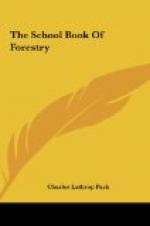The seed of trees requiring little light may be scattered in a dense forest together with that of trees which need plenty of daylight in order to make normal growth. The seedlings that like shade will develop under such conditions while those that need light will pine away and die. Gradually the shade-loving trees will replace the light-loving trees in such a forest stand. Even the different trees of the same family often strive with one another for light and moisture. Each tree differs from every other one in shape and size. Trees will adapt themselves to the light and moisture conditions to which they are exposed. A tree that has access to plenty of moisture and sunlight grows evenly from the ground to its top with a bushy, wide-spreading crown. The same tree, if it grows in the shade, will reach a greater height but will have a small compact crown. Trees run a race in their rapidity of growth. The winners get the desirable places in the sunlight and prosper. The losers develop into stunted trees that often die, due to lack of light exposure. A better quality of lumber results from tall straight trees than that produced by the symmetrical, branching trees. That is why every forester who sets out trees tries to provide conditions which will make them grow tall and with the smallest possible covering of branches on the lower part of the trunks.
Where trees are exposed to strong winds, they develop deep and strong root systems. They produce large and strong trunks that can bend and resist violent winds which sway and twist them in every direction. Such trees are much stronger and sturdier than those that grow in a sheltered forest. The trees that are blown down in the forest provide space for the introduction and growth of new varieties. These activities are constantly changing the type of tree growth in the forest.
Our original forests which bordered the Atlantic coast line when America was first settled, were dense and impenetrable. The colonists feared the forests because they sheltered the hostile Indians who lurked near the white settlements. In time this fear of the forest developed into hatred of the forest. As a result, the colonists cut trees as rapidly as they could. In every way they fought back the wilderness. They and their children’s children have worked so effectively that the original wealth of woodlands has been depleted. At present, cleared fields and cutover areas abound in regions that at one time were covered with magnificent stands of timber.
In many sections of the country our forests are now so reduced that they are of little commercial importance. However, these areas are not yet entirely denuded. Predictions have been made frequently that our woodlands would soon disappear. Scientific foresters report that such statements are incorrect. There are only a few districts in the country which probably will never again support much tree growth. Their denuded condition is due largely to the destruction




